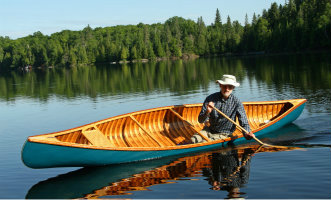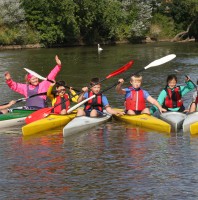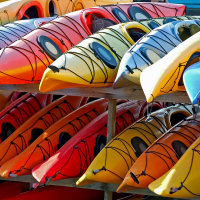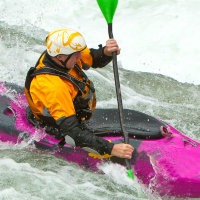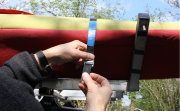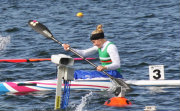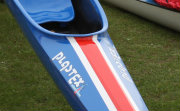Your First Sprint Regatta?
What to expect & What to do
This guide to sprint regattas had been written specifically for those attending their first races as part of the UKs main National Sprint Regatta series. Much of the advice will apply to you wherever your first race is.
At the Sprint Regatta Race Course - Where to go when you arrive
Take a look at this map so that you can find your way around when you arrive. (Print it out to take with you)
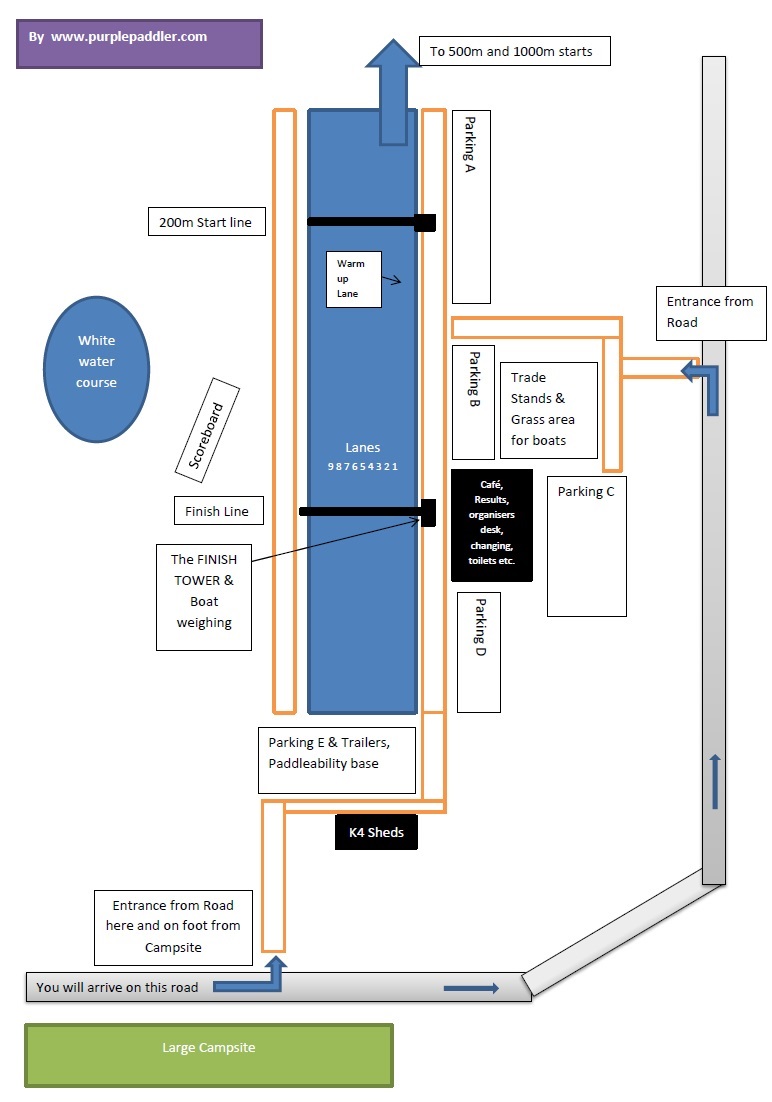
The first thing to do is locate your fellow paddlers and your boat / boats (if you did not bring them yourself). Many clubs have a specific are where they try to park, show them this map and ask them which parking area they use then you will find it easier to find them. Find them and park up nearby. You won't find the parking labelled A, B, C etc. we have added these to help you identify the areas when talking to others who have this map in front of them.
Boat Weighing and Setting up K2s1. Get your boats unloaded and check all the fittings are ok sometimes wingnuts can come loose on a long journey. 2. Take your boats and get them weighed. K1s should be 12kg or heavier and K2’s 18kg or heavier. Your boat's weight can be checked at the bottom of the finish tower. You will need to tie in or fix any additional weight you need to add. Early on the first day of the regatta there may well be a queue as everyone is getting themselves sorted out. Allow a bit of extra time. 3. If you are sharing boats make sure you know where the boat is going to be and whether you are going to need to move seats or footrests before your race. 4. Get all seats and footrests set up to the right length unless someone else is using the boat before you. Watch and Learn (if you have time)5. Go to the start and watch a few races start. Don’t worry about how fast they go just listen to what the starter says and where the paddlers go and what they do. The starter will usually be patient with newer paddlers so don’t worry. 6. Make a note in your head of which lane you are going to be in and where it is. 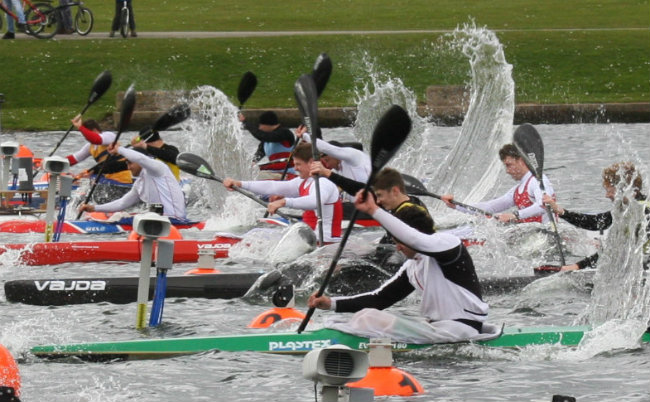 No one expects you to do this at your first regatta - but watch some of the racing to see how fast they go! Getting Ready to Race7. Take a look at the course and you will see lanes set out. Work out which is your lane. 8. You need to have a yellow number board on your boat showing your lane. Most clubs have a number of sets of numbers, find out who has them and get the number you need put on your boat. Don't forget to return it afterwards as someone else will be needing it. Warm up & When to get on9. Don’t forget to wear your club racing vest and don’t forget your number board. 10. You need to be in your boat heading up to the start line about 20 minutes before your race. This gives you time to paddle to the start area and do a short warm up. (Experienced paddlers will want to warm up for longer before racing). You must stay in the warm up lane and not get in the way of people who are racing. 11. There is a clock near the start which shows the time, keep an eye on how long it is until your race. Paddle about or rest near the start for the last 5 minutes before your race. The Race12. Listen for the starter to call up your race it will be something like this: Next race on course is race 87, Boys D Heat 4. (So you need to know your race number, class and heat. You also need to know your lane number as you can’t see it when its on the back of your boat!). 13. Move into your lane, The starter will run through the surnames of the people in the race. Listen out for your name. He or she will ask paddlers in that race to approach the yellow buoys. Paddle slowly towards the start line. Don’t be first and don’t be last. Watch the others and paddle up with them. 14. The starter will ask you to move onto the start line. Paddle up to the bucket and put the front of your boat into the V shape. This is quite easy unless the wind is coming from the side or from behind. Then it can be quite difficult for everyone. The trick is to paddle up slowly and back paddle to stop your boat from being pushed sideways. Keep doing backwards strokes to stay just in the bucket for as long as you need to. With a tail wind don’t get into the bucket before everyone else is ready or you will be back paddling for a long time. 15. When everyone is in the buckets the starter will say Ready, Set and then there will be a starting gun. The buckets will whoosh a bit and completely disappear. You will not be able to hit them so don’t worry, just start paddling your race is underway! After you Finish16. When you cross the finish line be you first or last take a moment to recover but listen out for the call to boat weighing. The person doing the commentating will ask one or more boats (by lane number) to go to boat weighing. This is done mostly at random. You will need to go to the boat weighing area straight away and have your boat weighed. 17. If you are not called have a short paddle around to recover then get off the water and put your boat somewhere safe. You might spot the result of your race on the big score board but often you miss it so don’t wait around for it. 18. Get changed into dry kit as soon as possible and have something to drink and maybe a little to eat. 19. After about half an hour go and find the results in the main building. You need to find out whether you are in a final and if you are in a final you need to find the lane draw so you know what number to put on your boat. This all happens on the results board in the main building. If you are in a final you must compete or your club will get penalty points. If you look like coming last in your final don’t worry you may go better than you expect and its all good training and practise. Your final may also be a closer race than your heat so it should be good to take part in. Don’t relax until you have checked when your next race is and made sure you know when to get ready for it. |
Canoe SprintHave you ready our introductory page on Canoe Sprint yet? or our page on Sprint Racing in the UK? 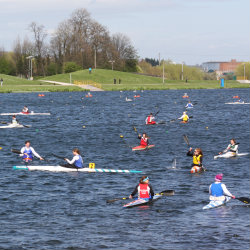 Warming Up 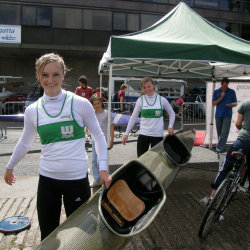 Boat Weighing 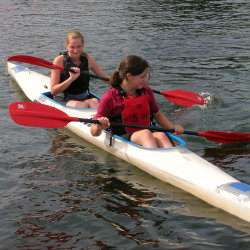 Girls D Paddlers at their 1st Regatta 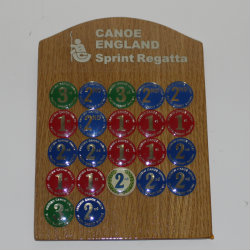 Junior? Aim to start a Tiddlywink Collection! |
Boat Weighing and Setting up K2s
1. Get your boats unloaded and check all the fittings are ok sometimes wingnuts can come loose on a long journey.
2. Take your boats and get them weighed. K1s should be 12kg or heavier and K2’s 18kg or heavier. Your boat's weight can be checked at the bottom of the finish tower. You will need to tie in or fix any additional weight you need to add. Early on the first day of the regatta there may well be a queue as everyone is getting themselves sorted out. Allow a bit of extra time.
3. If you are sharing boats make sure you know where the boat is going to be and whether you are going to need to move seats or footrests before your race.
4. Get all seats and footrests set up to the right length unless someone else is using the boat before you.
Watch and Learn (if you have time)
5. Go to the start and watch a few races start. Don’t worry about how fast they go just listen to what the starter says and where the paddlers go and what they do. The starter will usually be patient with newer paddlers so don’t worry.
6. Make a note in your head of which lane you are going to be in and where it is.

No one expects you to do this at your first regatta - but watch some of the racing to see how fast they go!
Getting Ready to Race
7. Take a look at the course and you will see lanes set out. Work out which is your lane.
8. You need to have a yellow number board on your boat showing your lane. Most clubs have a number of sets of numbers, find out who has them and get the number you need put on your boat. Don't forget to return it afterwards as someone else will be needing it.
Warm up & When to get on
9. Don’t forget to wear your club racing vest and don’t forget your number board.
10. You need to be in your boat heading up to the start line about 20 minutes before your race. This gives you time to paddle to the start area and do a short warm up. (Experienced paddlers will want to warm up for longer before racing). You must stay in the warm up lane and not get in the way of people who are racing.
11. There is a clock near the start which shows the time, keep an eye on how long it is until your race. Paddle about or rest near the start for the last 5 minutes before your race.
The Race
12. Listen for the starter to call up your race it will be something like this:
Next race on course is race 87, Boys D Heat 4. (So you need to know your race number, class and heat. You also need to know your lane number as you can’t see it when its on the back of your boat!).
13. Move into your lane, The starter will run through the surnames of the people in the race. Listen out for your name. He or she will ask paddlers in that race to approach the yellow buoys. Paddle slowly towards the start line. Don’t be first and don’t be last. Watch the others and paddle up with them.
14. The starter will ask you to move onto the start line. Paddle up to the bucket and put the front of your boat into the V shape. This is quite easy unless the wind is coming from the side or from behind. Then it can be quite difficult for everyone. The trick is to paddle up slowly and back paddle to stop your boat from being pushed sideways. Keep doing backwards strokes to stay just in the bucket for as long as you need to. With a tail wind don’t get into the bucket before everyone else is ready or you will be back paddling for a long time.
15. When everyone is in the buckets the starter will say Ready, Set and then there will be a starting gun. The buckets will whoosh a bit and completely disappear. You will not be able to hit them so don’t worry, just start paddling your race is underway!
After you Finish
16. When you cross the finish line be you first or last take a moment to recover but listen out for the call to boat weighing. The person doing the commentating will ask one or more boats (by lane number) to go to boat weighing. This is done mostly at random. You will need to go to the boat weighing area straight away and have your boat weighed.
17. If you are not called have a short paddle around to recover then get off the water and put your boat somewhere safe. You might spot the result of your race on the big score board but often you miss it so don’t wait around for it.
18. Get changed into dry kit as soon as possible and have something to drink and maybe a little to eat.
19. After about half an hour go and find the results in the main building. You need to find out whether you are in a final and if you are in a final you need to find the lane draw so you know what number to put on your boat. This all happens on the results board in the main building.
If you are in a final you must compete or your club will get penalty points. If you look like coming last in your final don’t worry you may go better than you expect and its all good training and practise. Your final may also be a closer race than your heat so it should be good to take part in.
Don’t relax until you have checked when your next race is and made sure you know when to get ready for it.
Collecting Prizes
If you do well enough to come first, second or third in a first final and you are a junior go to the competition organisers desk and collect your Tiddlywink as a prize. Even if you came last don’t feel down, everyone starts somewhere and you have lots of room for improvement.
K4 Races at Sprint Regattas
If you are entered for a K4 race you will probably be using a K4 from the boat sheds at the end of the lake. Be warned it can take a long time to set these up especially if you have juniors with short legs in the boat!
Find your crew before the race to make sure you all know each other and agree to meet at the boat sheds at least 45 minutes before your race. You will need some adults with you to be allowed to get the boat out.
When you get to the boat shed find the person in charge who will tell you which boat you can use.
Sort out where you are going to put the boat while you set it up then move it. You will need a strong person at either end and two people in the middle to lift it.
Try to sort out the footrests and seat positions before you get on the water but get on the water in plenty of time as sometimes you need to make last minute adjustments which take a lot longer than a minute!!!
Have fun in the K4 and remember it will go best if you are all in time and not arguing!!!
Finally - Don't Worry
Enjoy your racing and don't worry. Ask you club mates for help and advice, they all did their first race once. Ask their families as well they will know where everything is. A rescue boat is always on hand so the worst that can happen is you get wet!
Canoe Sprint
Have you ready our introductory page on Canoe Sprint yet? or our page on Sprint Racing in the UK?

Warming Up

Boat Weighing

Girls D Paddlers at their 1st Regatta

Junior? Aim to start a Tiddlywink Collection!
- Home
- Sprint Racing UK
- Sprint Regatta
